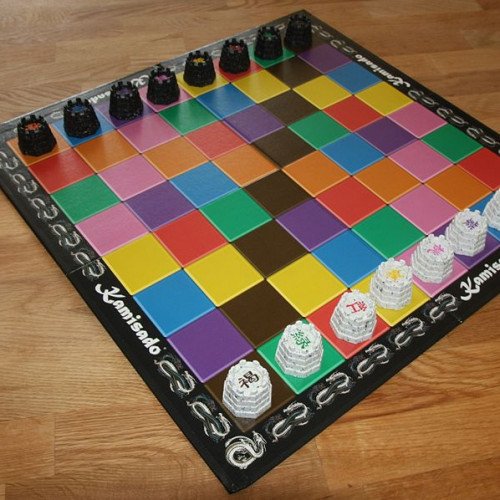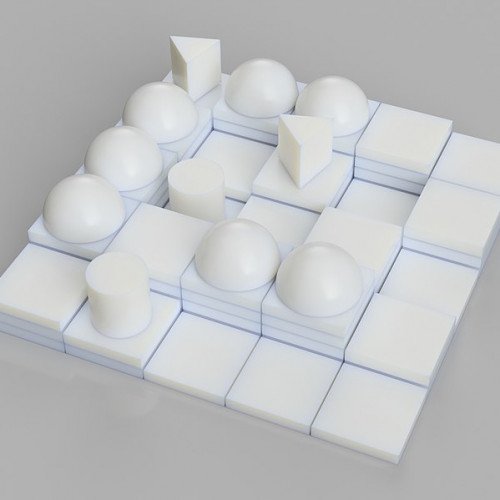KAMISADO VS SANTORINI

KAMISADO
Kamisado is an abstract strategy board game for two players that's played on an 8x8 multicoloured board. Each player controls a set of eight octagonal dragon tower pieces. Each player's set of dragon towers contains a tower to match each of the colours that appear on the squares of the board (i.e., a brown tower, a green tower, etc.). One player's towers have gold dragons mounted on the top, while the other player's towers are topped with black dragons. In an interview, designer Peter Burley said that the design of Kamisado dated back to a chance observation in a men's room in the 1970s. "I noticed that the floor had an interesting pattern of small colored tiles", he said. "I mentally made a note that this could possibly be used as a basis for a board game – this is something that I do quite a lot, whenever I see something a bit different. It must have made a deep impression on this occasion, however, because that night I had a vivid dream involving this tile pattern, and somehow the notion of 'whatever colour you land on, your opponent must move a piece that matches this'. I guess my subconscious mind had been working on this and sorted it out while I was asleep." The players’ towers start the game on the row nearest to them. The players take turns moving one tower any number of spaces in a straight line, either directly forwards or diagonally forwards, but not into or through a square already containing another dragon tower. The player with the black dragons moves first and may choose any tower. From this point onwards, each player must move the dragon tower that matches the colour of the square that the opponent's last move finished on. The object of the game is to reach your opponent's Home Row with one of your dragon towers. The first player to achieve this goal is the winner of the round. Games may be played as single rounds, or as more advanced ‘Match’ formats. Matches are played up to 3 points (Standard Match), 7 points (Long Match) or 15 points (Marathon Match). During a match, each time a round is won, a special ‘Sumo Ring’ is added to the dragon tower that has fought its way through to the opponent's Home Row. The sumo rings provide the scoring system for the game, and also endow special powers to the dragon towers that carry them. These towers are known as Sumo towers and have the ability to push opponent's towers back one space, by using a move known as a ‘Sumo Push’.
Statistics for this Xoptio

SANTORINI
Santorini is an abstract strategy board game for 2-4 players designed and released in 2004 by Gordon Hamilton and republished via Kickstarter in 2016 by Roxley Games. Inspired by the architecture of cliffside villages on Santorini Island in Greece, and primarily designed for two players, the game is played on a grid where each turn players build a town by placing building pieces up to three levels high. To win the game, players must move one of their two characters to the third level of the town. Each turn of play involves moving one of your two pieces around a 5-by-5 grid each turn and then placing a tile adjacent to the moved piece, building up that spot of the board. On subsequent turns, pieces may be moved onto one of these built-up tiles, but only one level up at a time. Pieces may also be moved down any number of levels. Players may also place a special dome tile on top of a three-level building, which prevents a player from moving onto that spot for the remainder of the game. The primary winning condition is to get one of your pieces onto the third level, though players may also win if their opponent is unable to make a move. The Roxley Games version of Santorini introduced a god powers variant, which gives each player a unique way to break the rules. After being directly released and sold by Hamilton in 2004, Roxley Games ran a Kickstarter campaign during March-April 2016, drawing over 7,100 backers and raising over C$700,000, the most successful Kickstarter campaign ever based in Alberta. While the original release used plain white blocks as components, the Roxley version featured an enhanced cartoon-like look to the game, which Hamilton credits for success of the Kickstarter campaign. The game was released in retail outlets in January 2017.